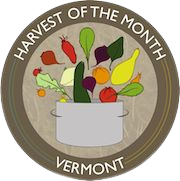Apples
Apples need a cold winter to grow well. So, you can grow apples in Vermont, but not in tropical places. Apples are part of the rose family (Rosaceae), along with almonds, cherries, peaches, pears, plums, raspberries, and strawberries.
Downloads (PDF):
Slideshow:
Reading List:
» The Apple Grower: A Guide for the Organic Orchardist, by Michael Phillips
» Apples of Uncommon Character, by Rowan Jacobsen
» Apples, Apples, Apples, by Nancy Elizabeth Wallace
» Apple Picking Time, by Michele Slawson
» Applesauce Season, by Eden Ross Lipson
» How do Apples Grow? by Betsy Maestro
» How to Make an Apple Pie and See the World, by Marjorie Priceman
» Johnny Appleseed, by Steven Kellogg
» Our Apple Tree, by Görel Kristina Näslund
Recipes:
Articles:
Liberation Story:
Apples have long symbolized opportunity—but behind many orchards is a story of resilience.
You might bite into a crisp Vermont apple without realizing the hands that helped grow it. For generations, immigrant farmworkers—many from Mexico and Central America—have come to the U.S. to support their families and contribute to the harvest.
Apples aren’t native to North America. Like many immigrants, they’ve traveled and adapted. Brought over by colonists, cultivated by Indigenous and immigrant farmers alike, apples now grow in nearly every U.S. state.
Just as the apple took root in new soil, immigrant communities have nourished this land— through labor, knowledge, stories, and food traditions that enrich our collective food culture. Their role is central, even if it’s often easily overlooked.


